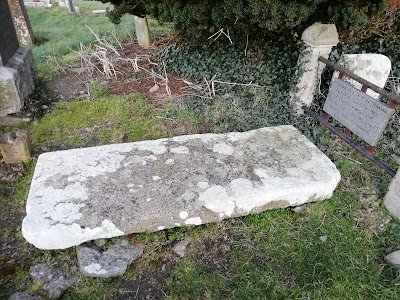Thursday 9 November 2023
Lea Castle, Portarlington
Tuesday 7 November 2023
An Offaly Headache Stone
An Offaly Headache Stone
In the Offaly townlands of Clonsast and Clonshannon lie the sparse ruins of what's believed to have been an early medieval Church. Little remains now other than a few small portions of the walls.
Nearby is also to be found Saint Broghan's Stone, a large single Bullaun stone reputedly used to cure headaches and Saint Broghan's Holy Well.
Saint Broghan/Brochan, originally from Scotland, is reputed to have founded a Monastery here in the 7th century.
The Saint is also known as Bearchán, Brachan and Berchán.
At one time in early Christian Ireland he is believed to have been of major importance though the Saint today is an obscure figure.
The Holy Well has a Statue of the Saint in a small enclosure and is very well maintained although it lies across deep muddy fields and may be difficult to access depending upon the time of year you visit.
Saint Broghan's Stone is about 800 metres Southsoutheast from the Well. It lies several fields away across boggy wet ground and is difficult to find.
It is believed that the Bullaun stone was formed from the impression of Saint Broghan's head. Water would be taken from the Holy Well and placed into the depression on the stone.
A person then placed their head into the water on the stone and divine intervention or a cure for headaches and illness thereof was petitioned for in the hope of intercession.
Unfortunately today the stone has cracked across the basin and would no longer hold water. Presumably it has been many years since it was last used as a Headache stone.
Despite the stones damage it was nonetheless interesting and somewhat refreshing to see the Well, the Church ruins and the Headache stone all still "in situ" near each other.
There is a small Cairn of unknown origin beside the Bullaun and both lie about 100 metres Southeast of the Church remains. There is also a thorn tree (either Haw or Blackthorn) beside the Bullaun called Saint Broghan's Thorn on OSI Historic Mapping.
At one time up to 1500 people gathered here on the Saint's Patten Day and there was also a week long festival.
Apparently the week long festival was eventually abandoned due to outbreaks of alcohol induced happiness which the clergy understandably frowned upon.
The nearest village to these sites is Bracknagh with a population of around 200 people. The small 1800's Roman Catholic Church here is called Saint Broghan's Church.
An ancient road, a Togher/Tochar of gravel, brushwood and sticks once ran from the site in a westerly direction across a bog. It was known as Saint Broghan's road.
Sources and further reading:
jstor.org - Saint Broghan's Road
www.duchas.ie Schools Collection - Saint Broghan's Well
www.duchas.ie School's Collection - The Local Patron saint
Saint Broghan's NS - Our History
Omnium Sanctorum Hiberniae - Saint Berchán
Monday 6 November 2023
Dysert O'Dea Romanesque Church and Saint Tola's High Cross, Clare
Dysert O'Dea Romanesque Church and Saint Tola's High Cross
Clare Library - Saint Tola's Cross
Corpus of Romanesque Sculpture in Britain and Ireland
County Clare Heritage Office - Saint Tola's Well
Discover Ireland Clare archaeology centre
Clare County Library - Dysert O'Dea Church
-------------------
About 2 Kilometres nortwest of Dysert O'Dea is an old historical ruined Church at Rath, County Clare. Here you can find a badly worn Sheela na Gig next to a 12th century window carving.
It is positioned upside down if you can spot it.
There may have been a Church here going as far back as the 9th century and a Round Tower that once stood on this site was demolished sometime in the 1800's.
Coordinates here:
.jpg)
.jpg)
.jpg)

.jpg)
.jpg)
.jpg)
.jpg)
.jpg)
.jpg)
.jpg)
.jpg)
.jpg)
.jpg)
.jpg)
.jpg)
.jpg)
.jpg)
.jpg)
.jpg)
.jpg)
.jpg)
.jpg)

.jpg)
.jpg)
.jpg)
.jpg)
.jpg)
.jpg)
.jpg)
.jpg)
.jpg)
.jpg)
.JPG)
.JPG)
.JPG)
.jpg)
.JPG)
.JPG)
.JPG)
.JPG)
.JPG)
.JPG)
.JPG)
.JPG)
.JPG)
.JPG)
.JPG)
.JPG)
.JPG)
.JPG)
.JPG)
.JPG)
.JPG)
.JPG)
.JPG)
.jpg)
.JPG)
.JPG)
.JPG)
.JPG)
.JPG)
.JPG)
.JPG)
.JPG)
.JPG)
.JPG)
.jpg)
.JPG)
.JPG)
.jpg)
.jpg)
.jpg)
.jpg)
.jpg)
.jpg)
.jpg)
.jpg)
.JPG)
.JPG)
.JPG)
.JPG)
.JPG)
.JPG)
.JPG)
.JPG)
.JPG)